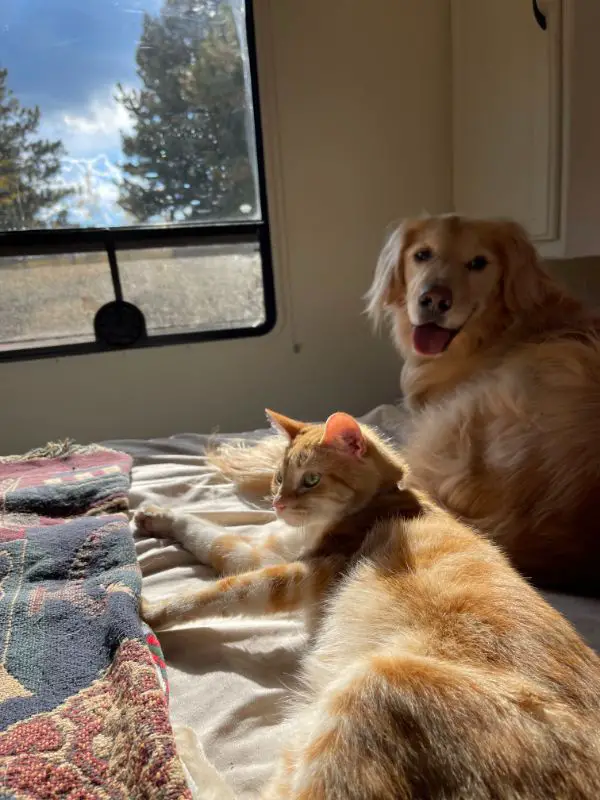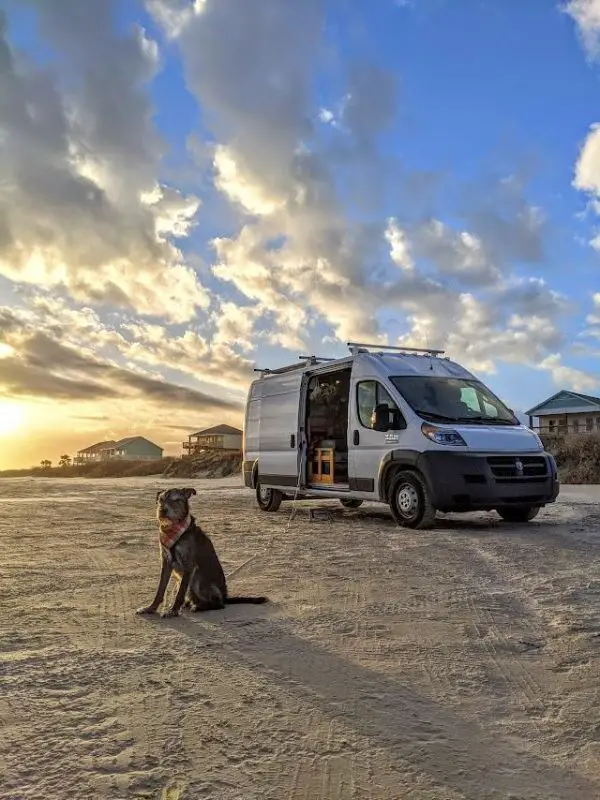According to Dave Barry, who is by no means an authority but who is nonetheless correct, dogs are honest to a fault and cats have the morals of Hannibal Lecter. Don’t get me wrong, I love both dogs and cats, but they are undeniably different. These differences must be first confessed and then carefully considered before hitting the road with your pets.
Because cats and dogs are significantly different, we’ll explore each species independently of the other beginning with cats, not because they believe they are superior to dogs but because they are defined first in the dictionary. Once we’ve addressed each species specifically, we’ll bring them both together and hope the fur doesn’t fly.
RVING WITH CATS

“Cat: (n) a small domesticated carnivorous mammal with soft fur, retractable claws, and a marked superiority complex.”
~ The Definitive Dictionary of Small Mammillae. (Just kidding. I made that up.)
Okay, so anyone who owns cats knows that the only thing all cats have in common is that they operate on their own terms. That, and also that they are all liars. If you don’t believe me, just ask them when you fed them last. Depending on how many cats you own, they will give you lies ranging from days to years, and they’ll do it with totally straight faces. Kittens, who are simply smaller, inexperienced liars, might tell you the truth, but if they do it’s only because they don’t yet know how to tell time and they threw it out at random.
Because cats differ so greatly from one another, telling you what you need to do to get your cat ready for a road trip feels like something between making up a feasible excuse for speeding and trying to explain the difference between cocoa and coconuts to a semi-intelligent baboon. It’s not exactly impossible, but actually it is.
The truth is, your cat may never warm up to the idea of life on the road. The truth is also, your cat may absolutely love to travel! Determining which sort of cat you own is the single most important mystery you must solve before you begin planning your life of adventure. Below are some things you can do to shed some light on which kind of cat you have.
Practice Makes Purrfect
Cat’s, generally speaking, like routines. They wouldn’t fare well working in the tech industry, which is constantly changing. This is precisely why you don’t see many cats working at Space-X. There is simply too much change going on, and all that change is stressful. (They’re not fond of explosions either, so that could be another explanation.)
Since change is stressful to cats, the number one thing you can do to prepare your cats for RVing is to practice. Here are some practical tips to help ease your cats’ stress and get them ready for the big trip.
- Set up camp around your RV in your backyard and bring your cats along.
- Cookout and eat in your RV, inviting your cats in to explore and become familiar with their new environment.
- Use your RV as an extension of your home, spending time in there and even sleeping in there once your cats have become comfortable with it.
- Lean into leash training by beginning with a harness, sans lead, in a familiar environment. (At first, this will likely make your cat imagine you in all sorts of horrible, catastrophic scenarios, but because she can’t actually tell you to go to hell directly, you will hardly notice.)
Papers Aren’t Only For Pedigrees
Once you’ve discovered that your cat is not stuck in a rut and refusing to budge, you may begin planning your life of adventure! This is fantastic news because it means that your cat is not a pedigree fuddy-duddy! Regardless of how cool your cat may look in her hot pink harness and dark sunglasses, however, one thing she cannot go without is her pawsport, aka vaccination records.
If you have not had your cat vaccinated, there is a good chance that you will not be welcomed into your campground no matter when you booked your site. Begging and pleading won’t work either. Campgrounds are legally liable for any problems caused by critters they allow onto their land, and without proof of —at the very least—a rabies shot you’re going to end up boondocking at a Walmart.
Keeping copies of your cat’s vet records in with your purrrsonal paperwork will ensure that they are on hand and easily accessible whenever they are required.
Microchip, Photograph, And Protect
Any time you’re travelling with pets, there is the possibility of loss. No one likes to think about losing their beloved pet, but if you don’t prepare for such an eventuality (however remote it may seem), you are far less likely to recover your fuzzy friend should she get drunk and forget where she parked the RV.
Of course, I’m not in any way insinuating that your sweet, innocent floof is a closet lush who sneaks out in search of rowdy clowders, but hey, she’s only feline, right? Right. And I think we can all agree that no matter how civilized a house cat may be, she will always have at least one paw in the wild. Even if the wild can only be defined as behind the couch abusing an earwig, she’s got a paw in it, and we all know it.
In all seriousness, losing a pet is a heartbreaking experience that no one wants to go through. Having a pet stolen, however, is not only heartbreaking but also frustrating and infuriating. And if you don’t think this happens, you have far too much faith in your fellow hoomans.
Think about it. Your cat is not the average chair cheetah. Your cat is an awesome, adventurous, lead-trained, RV traveling gypsy of a mountain cat, and as such she is a highly desirable pet! Someone out there would absolutely love to have a pet just like her without all that effort and training and stuff. So, while injecting a microchip under your cat’s skin sounds like something out of a dystopian novel, when it comes to proving pet ownership, a microchip is as definitive as it gets. Photos of your cat’s distinct markings are also useful for proving pet ownership, especially when you are in the pictures, too.
RVING WITH DOGS

“Dog: (n) man’s best friend.” ~ Socrates
So, you may be wondering why anyone would need to read about RVing with a dog. And if you are, I’ll tell you: you have some time to kill while getting your oil changed or waiting for paint to dry. Of course dogs would do well in RVs! Seriously, that is a no-brainer!
But it’s not, actually.
While it’s true that dogs are legendary for loving car rides, long car rides can be trying on anyone’s patience. Now take into consideration that a dog has roughly the same intellect as a two-year-old human and you can see why six hours in the back seat for your boxer might be something of a serious downer. And if it’s a downer for your dog, especially a large dog or a vocal dog, it won’t be long before it’s a downer for you, too. (Or should I say more of a downer for you, because six hours in a car is enough to make me want to run off a cliff, and if it’s moving and I’m the one driving it, you do not want to be with me when five hours and fifty-nine minutes rolls around. I digress.)
The Dog, The Myth, The Legend
So, at the beginning of this article we talked about c*ts and how they are all different and how they don’t like this or that and blah, blah, blah. Well, I don’t mean to shatter your delusions, but dogs are kind’a wishy-washy in much the same way, and nearly everything I said about c*ts holds true for dogs, too.
Don’t shoot me! I’m only the messenger!
Okay, so let’s assume your dog is an outstanding example of dogdome, has been on hikes and treks and kayaks and surf boards and long, long, excruciating car rides, and has never as much as batted an eye. Good for you! Go read something else I’ve written because this article is for people who do not own your dog.
All Dogs May Go To Heaven, But Not All Dogs Go On Road Trips
Now that we saw that know-it-all off, let’s talk about motion sickness.
Puking is never a pleasant dinner-table topic, so I hope you’re not reading this over a plate of cottage cheese or oysters or something because puking is exactly the kind of thing I’m talking about when I say motion sickness. Puking, vurping, burping, hurking and all those other ing verbs can really trash a road trip. Dog farts suck, too. This is why you should never, never ever, assume that just because your dog adores trips to the park or the bank or the drive-through liquor store (here’s looking at you Detroit) that he’s instantly going to be your ideal RVing companion. If you make such assumptions, you may soon discover that dog feces is not the smelliest substance produced in a dog’s gut, nor is it the most difficult substance to clean out from all those teeny, tiny crevices that you didn’t know leather seats had.
So how can you tell if your dog is more road weenie than road warrior? (Hint: body length has nothing to do with it.) You can’t. And that’s why practice, much as it is for c*ts, is important when preparing your dog for the long haul.
Below are some practical tips to get you and your pooch on the road to RVing bliss.
- Read the suggestions listed under the heading Practice Makes Purrfect. (Imagine they are written about dogs and not c*ts.)
- If your dog has bad manners, consider taking him to basic training classes.
- Plan some short trips to build up your dog’s travel endurance.
- Take time to stop, walk, and play. Pooping is also encouraged.
Once you’ve spent some time in the car with your dog, you will have a pretty good idea of just how annoying he can be. You will also know if you should invest in pleather seat covers, a car crate (more on this later), or a larger television and a more comfortable couch from which to live vicariously through the Travel Channel and River Monsters.
DOGS AND CATS LIVING IN HARMONY
You’ve seen the images and the videos of dogs and cats living together in suggested harmony. This may or may not be a propaganda campaign put out by some shady, underhanded secret society, but I don’t think so. I have personally witnessed cats tolerating dogs on a level approaching friendly. I’ve even seen an actual cat laying atop an actual dog. (He tried to play it off as an attempted dogocide, but I think he was just acting tough.)
So, can dogs and cats coexist in an RV? If they can exist separately in an RV, and they can coexist in your home, the answer is definitely maybe!
Animals, much like people, are individuals. They each have their likes and dislikes, and they each react differently to different stimuli. So, if you’ve gone through the trouble of prepping your dog and cat (who presumably get along while you’re around) then try them out on a short trip or two and see if they can keep up the charade long enough to get to your destination. If so, by all means, feel free to take your chances. But don’t blame me for any sibling issues that arise. Remember, I am only the messenger.
SAFETY TIPS TO KEEP YOUR TRAILS (AND TAILS) HAPPY
Traveling is never 100 percent safe, and while traveling with your pets can be highly rewarding, it also adds an extra layer of risk. So what can you do to keep yourselves and your furkids safe? Here are some practical tips.
Never Ever!
It may seem counterintuitive to coop your pets up with you while you’re towing a spacious, well-furnished fifth wheel or camper, but allowing pets to roam freely while the vehicle is in motion is a huge, potentially fatal mistake.
While it may be true that you’re a fantastic driver who has never had a ticket in your life, nor has ever had as much as a single dent in your fender, the idiot passing you on the right going 90 mph with his phone in one hand and a slice of pizza in the other probably isn’t all that great at risk assessment. It only takes one bump to send stuff flying in your mobile earthquake machine, and even an unavoidable pothole could cost you the life of your pet.
Keeping your pets harnessed and buckled-up or resting in secure, travel-safe crates (I told you I’d mention these again) is the best practice when actively on the road. Remember, cats are fantastic liars, so no matter what they tell you, they do not need to be sitting in a sunny window. And while dogs probably won’t outright lie, they are master guilt trippers. Do not fall for it! If your furkids are asking are we there yet, it’s probably better for you to stop and rest for a while. Once you’re stopped, everyone can stretch their legs and safely rest.
Always, Always!
Make sure you have everything you need to keep your pets nourished and safe. Make a checklist of pet essentials, and be sure to check it every time you plan to move.
Here are some things to get you started.
- Vet/Vaccination records.
- Updated microchip information.
- Recent, decent, and detailed photos of yourself with your pets.
- Appropriate collars and identification tags.
- Harnesses and leads.
- Plenty of food.
- Poop scoopers and disposal bags.
- Fresh litter.
- Clean bedding changes.
- Grooming needs.
- Toys.
- Healthy treats.
- What else can you think of? Write it on the list.
A Final Note On Loss Prevention
We’ve touched on the necessity of pet identification and proof of ownership, but one way you can prevent the loss of your pet is to spay or neuter.
I know that some people, and by people I mean men, take exception to neutering. I don’t understand this personally, but I can only guess it’s because they view their dog’s testicles (or cat’s testicles) as some outward symbol of their own masculinity. I can think of no other reason for this mentality because neutered/spayed pets are proven to live longer, happier lives. There’s a reason for this, and it is both logical and reasonable: unaltered pets will instinctively seek opportunities to reproduce, and by this I mean they want sex and they will travel to get it. They will sometimes travel miles to get it. (I will refrain from looking at you, Tiger Woods.) If you get your pet back, they will continue to seek opportunities to answer the call of the wild, so to speak, and you will need to go on the search and rescue again and again. This is not safe for them, nor is it safe/convenient for you.
So, just to recap, if you are tired of your dog or cat stinking up the place and running off all the time, go have them neutered or spayed. They will be more content and much safer, and you will spend much less time on the search and rescue. All of this is to say nothing of the already astronomical loss of life caused by the dumping of unwanted animals at pounds and shelters.
Born and raised in Detroit, now a resident of Kansas City, Azaliah is an experienced author who specializes in creative nonfiction: articles, satirical pieces, short stories, novels, and blogs. She’s got a wicked sense of humor and loves to travel!
-
Azaliah Yadinahhttps://changingears.com/author/azaliah-yadinah/
-
Azaliah Yadinahhttps://changingears.com/author/azaliah-yadinah/
-
Azaliah Yadinahhttps://changingears.com/author/azaliah-yadinah/









